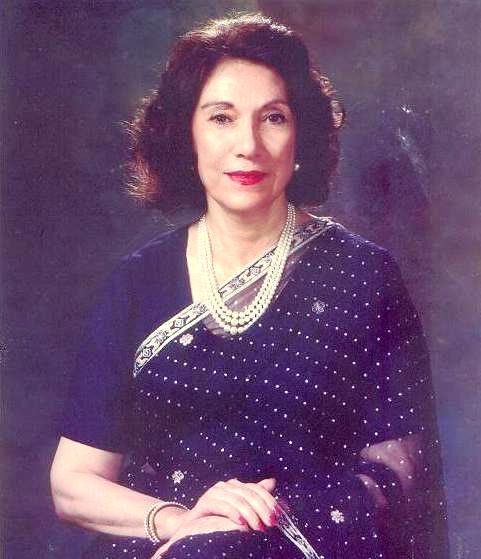Begum Nusrat Bhutto
Personal Details
Nusrat Ispahani was born on 23 March 1929 in Esfahan, Iran, hailing from the wealthy Hariri family. She was of
Kurdish descent. Her father was a wealthy Iranian businessman who initially lived in Bombay and the moved to Karachi, Pakistan before the independence of Pakistan in 1947. Before emigrating to Pakistan, Nusrat attended and was educated at the University of Isfahan where she obtained a Bachelor of Arts (B.A.) in Humanities in 1950. Nusrat met Zulfikar Ali Bhutto in Karachi where they got married on 8 September 1951. She was Zulfikar Ali Bhutto’s second wife, and they had four children together: Benazir Bhutto, Mir Murtaza Bhutto, Sanam Bhutto and Shahnawaz Bhutto.

Family and political career
As first lady from 1973 to 1977, Nusrat Bhutto functioned as a political worker and accompanied her husband on a number of overseas visits. In 1979, after the trial and execution of her husband, she succeeded her husband as leader of the Pakistan Peoples Party as chairman for life. She led the PPP’s campaign against General Muhammad Zia-ul-Haq’s regime. Alongside her daughter Benazir Bhutto, she was arrested numerous times and placed under house arrest and in prison in Sihala. Nusrat Bhutto was attacked by police with batons while attending a cricket match at Gaddafi Stadium in Lahore, when the crowd began to raise pro Bhutto slogans.
In 1982, ill with cancer, she was given permission to leave the country by the military government of Genera Zia-ul-Haq for medical treatment in London at which point her daughter, Benazir Bhutto, became acting leader of the party, and, by 1984, the party chairman.
After returning to Pakistan in the late 1980s, she served two terms as a Member of Parliament to the National Assembly from the family constituency of Larkana, Sindh.
During the administrations of her daughter Benazir, she became a cabinet minister and Deputy Prime Minister. In the 1990s, she and Benazir became estranged when Nusrat took the side of her son Murtaza during a family dispute but were later reconciled after Murtaza’s murder. She lived the last few years of her life with her daughter’s family in Dubai, United Arab Emirates and later suffered from the combined effects of a stroke and Alzheimer’s disease.
Illness and death
the last several years of her life, she had also been suffering from Alzheimer’s disease. In the mid-1990s, particularly after the death of her son Mir Murtaza Bhutto in 1996, she withdrew from public life. Party sources suggest this may also have coincided with the time that she began to show symptoms of Alzheimer’s.
According to her senior party leader, Bhutto’s disease was so advanced that she was even unaware of the assassination of her daughter, Benazir. She used a ventilator until her last days. She died at age 82 in Dubai on 23 October 2011. Her body was flown to her hometown of Garhi Khuda Bakhsh in Larkana District the next day, and was buried next to her husband and children in the Bhutto family mausoleum at a ceremony attended by thousands of mourners.

